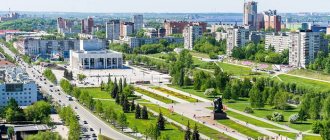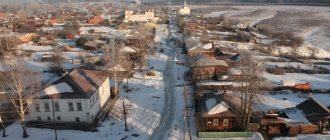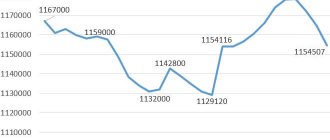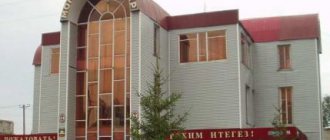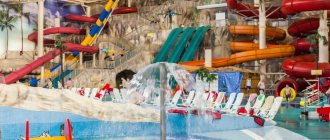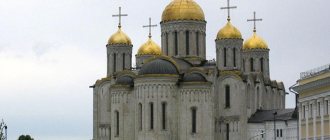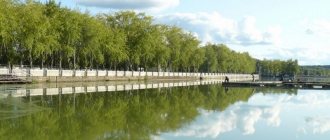Data by year
The first statistical calculations of the number of inhabitants were carried out at the beginning of the 19th century. According to information for 1811, 3,100 people lived in Perm. As local industry and trade develop, this figure increases significantly. In 1863 there were already 19,200 inhabitants, in 1897 45,205, and in 1913 - 68,100. After the October Revolution, the population grew almost as quickly. In 1926, 126,100 residents lived in Perm, in 1939 - 255,236, in 1956 - 538,000. Gradually, the city was able to cross the million mark. In 1979 the number of inhabitants was 999,157, in 1982 - 1,028,000, in 1991 - 1,100,000.
During the period of socio-economic instability, there was a significant decline in the number of residents in this locality. As of 1992, the population was 1,099,000, in 1998 - 1,023,000, in 2005 - 989,500. Perm lost its status as a millionaire city. True, after a few years it was regained.
Since 2009, there has been a steady increase in the number of people living in Perm. This year it amounted to 985,794 people, in 2012 - 1,000,672, in 2022 - 1,053,938.
Create conditions
One of the important elements in the “fight” against migration of young people from the region is education and the opportunity to get a decent job after graduating from university.
vk.com / Perm State University
Perm University (PGNIU) is a classic university that unites representatives of all main areas of science - 12 faculties, 128 areas and 177 laboratories, four of which are world-class. Among 48 Russian universities, Perm State National Research University was included in the Quacquarelli Symonds ranking of the best educational institutions in the world, and it is also among the top 100 in the aggregated national ranking of universities.
“The summer school with the University of Oxford is unique for Russia. We are the only university that has been implementing such a program since 2012. These efforts have been highly appreciated by our partners in the UK. We are the only university that has a special distinction - the gold standard for internships,” the university told FAN.
Today, Perm State National Research University cooperates with leading companies in the Kama region that provide internships for students and are interested in hiring graduates. The university has currently concluded 214 agreements and cooperation agreements (67 with foreign organizations) and more than 900 agreements on internships and internships for students. Among the partner companies are Lukoil, PNPPC, Uralkali, ER-Telecom Holding.
“A unique NTI Photonics Competence Center has been created on the basis of Perm State National Research University. Now he is attracting the best Russian specialists in this end-to-end technology. The presence of such infrastructure opens up enormous opportunities for students and university staff. The developments of university scientists are translated into production and market products. We are also a key participant in the federal project of the world-class Scientific and Educational Center “Rational Subsoil Use,” the university clarified.
The campus of Perm State National Research University itself takes on the outlines of a small European town. On the territory there are 13 educational buildings, a square with a fountain, a Botanical Garden, eight museums, reading rooms, a sports club and its own palace of culture.
City `s history
The territory of Perm has been inhabited since prehistoric times. Scientists have identified and studied 130 archaeological monuments (settlements and burial grounds), the time range of which is from the Paleolithic to the late Middle Ages (XIV-XV centuries).
The founding date of Perm in science is considered to be the day the construction of the Yegoshikha plant began. It was started on May 4, 1723 according to the old style. On November 16, 1780, a personal decree of Empress Catherine II was issued, according to which the plant was transformed into the city of Perm. Administrative buildings for government institutions were hastily built on the factory land, and construction of roads began - the famous Siberian and Kazan highways. Finally, on October 18, 1781, the grand opening of the city and the local governorship took place. In 1796, a new significant event occurred. The Perm governorship was liquidated, and a corresponding province was formed in its place.
During the 19th century there was active development of industry and transport. In 1871, the Perm Cannon Factory was founded in the village of Motovilikha. In 1876, the first open-hearth furnace was launched there. This enterprise was engaged in the production of artillery for the Russian army and played a huge role in local and national history. It was at this plant that a significant share of Soviet artillery was produced during the Great Patriotic War. Today it is the main manufacturer of artillery pieces for the Russian armed forces.
In 1878, the Perm-Kushva-Ekaterinburg railway line was completed. In 1897-1898, a railway line to Kotlas was built, connecting the city with the ports of the Northern Dvina.
After the October Revolution and the subsequent civil war, the city's rapid socio-economic development continued. On November 3, 1927, the city was united with the workers' village of Motovilikha. In 1930, construction began on plant No. 19, which later began to bear the name of Stalin and then Sverdlov. Now it is called the Perm Engine-Building Complex. It produces aircraft and rocket engines, equipment for gas pumping power plants.
During the years of industrialization, the number of city residents triples. In 1940, the city received the name Molotov, in honor of one of the prominent Soviet leaders, Vyacheslav Mikhailovich Molotov. The old name was returned only on October 2, 1957. During the Great Patriotic War, the city was the most important center of the Soviet military industry. Artillery pieces, ammunition, and aircraft engines were produced here.
After the Great Patriotic War, the development of Perm continued to surge. New microdistricts are being actively built with modern houses. On January 23, 1971, a significant event took place - the awarding of the Order of Lenin for success in implementing the five-year plan. The 90s were characterized in Perm, as throughout the country, by extreme economic instability. Recently, negative trends have been partially overcome. Active improvement of the city, construction of housing, transport and social facilities continues.
Sights of Perm
The main railway station of the city is called Perm II. In the park named after To mark the 250th anniversary of Perm, near the station there is a huge art object, the Perm Gate , 12 m high, created by artist Nikolai Polissky. This is a kind of Arc de Triomphe or a three-dimensional letter “P”, oriented on all four sides. Perm gates are made of numerous tree trunks attached to a metal frame. For some reason, Perm residents did not like this original art object and tried to burn it several times.
Nearby is another unusual art object - a scarab beetle , which rolls a large ball in front of it. All this is made of a metal frame and rubber tires. Author: M. Narymbetov.
From here, along Lenin Street you can get to the city esplanade - a large walking area and venue for celebrations. The esplanade occupies three blocks between the Perm Academic Theater and the Administration of the Perm Territory. In winter, the main city ice town and skating rink operate on the esplanade, and in summer festival towns appear.
Approximately in the center of the esplanade there is a monument to “Heroes of the Front and Rear . The 10-meter monument was created by sculptor V.M. Klykov, opened in 1985. Here are depicted a warrior with a sword, a factory worker and their mother - a symbol of the Motherland. The monument was conceived as a symbol of the unity of the three components, which together brought victory over fascism.
The Walk of Valor and Glory is located nearby . The names of the most prominent residents of Perm are inscribed on the slabs.
Across the road, on the other side of Lenin Street, in front of the library building. A.M. Gorky you can see the art object “Apple” . The 3m diameter object is based on old bricks, and the outside skin is made of ceramic tiles. According to the author, Zhanna Kadyrova, the apple is depicted as being bitten, which turns it from a symbolic object into an object of consumption.
Previously, there were much more such art objects in the city. Due to outrage from some of the townspeople, they were removed. Among them were “red men”.
In front of the next building (Lenin St., 68) there is a monument to the inventor of radio A.S. Popov . The sculpture shows the future inventor as a young man, during his studies at the Perm Theological Seminary. A receiver and transmitter, made from real samples, are located near the sculpture.
Further along Lenin Street, in front of the main administrative building of the LUKOIL-Perm company, there is a monument to the discoverer of oil and potassium in the Urals P.I. Preobrazhensky , as well as an art object in the form of arches glowing in the dark.
In 2010, the sculpture “Kama River” . The composition symbolizes the ancient traditions of the Perm land. The boat depicts the Kama River, it rests on stone “pillars of history”, on which you can see figures of the Permian animal style.
Nearby in the same park there is a sculpture “The Legend of the Perm Bear” . It was installed in 2009. The idea of its origin is connected with the stereotype of foreigners that “bears walk along the streets of the Ural (and Russian) cities.” The bear has long been a symbol of Perm and the Perm region and is depicted on coats of arms. The sculpture is popular. It can be difficult to figure out how to photograph it without people. The bear's nose was rubbed until it shined. It is believed that if you make a wish and touch the bear's nose, your wish will come true and you will have good luck in your business.
If you walk a little up Komsomolsky Prospect, then in front of the Prikamie Hotel (Komsomolsky Prospekt, 27) you will see the most popular monument of the city - “Permyak - Salty Ears” . This was the joking name given to the residents of the Kama region who were engaged in salt mining. Because the workers carried bags of salt on their shoulders, the salt got on their heads and corroded their skin. The ears turned red and swollen. The sculpture was installed in 2006. It consists of two parts: a bronze frame with large ears, standing next to which you can take an original photo as a keepsake, and a sculpture of a photographer with an old camera. The author of the first part is Rustam Ismagilov, and the second is Alexey Matveev.
Komsomolsky Prospekt (locals call it Kompros) is considered the main street of Perm. There is a cozy alley running through its center. At the very beginning of Kompros there is Cathedral Square, on which stands the Transfiguration Cathedral (Komsomolsky Prospekt, 4). In the past, the Pyskorsky Spaso-Preobrazhensky Monastery was transferred to this place. Construction of the cathedral began in 1798, and it acquired its modern shape by 1832. Even earlier (in 1793-98), the Bishop's House was built nearby - the second stone building in the city. The 67 m high bell tower has long been the main dominant feature of Perm, and now this building is one of the symbols of the city.
The cathedral building houses the Perm Art Gallery , the most famous museum in the city. The gallery opened in 1922. Its holdings include more than 50 thousand objects of art, including well-known authors (Repin, Levitan, Savrasov, Serov and others). There is also a large collection of Stroganov icons. But still, the most unique exhibits in the gallery are the iconic Perm wooden sculpture, the so-called “Perm gods”.
Behind the cathedral building, on the site of an ancient cemetery, there is a zoo . The zoo has long become crowded in the city center. Now a new site is being built for it.
From Cathedral Square there is a very beautiful view of the Kama River and the bridge across it. From here you can go down to the city embankment . There is a beautiful rotunda nearby.
The Perm embankment was recently restored. During the summer, various interesting events are held here on weekends. The embankment is not long - about 2 km. It stretches from the River Station to the port. The rest of the coastal space is occupied by numerous industrial zones. A railway runs along the embankment. They plan to close it soon, despite the indignation of residents, who will find it much more difficult to board trains.
I recommend taking a walk along the embankment to the River Station (Monastyrskaya St., 2). This building was built in 1932-40 in the Stalinist Empire style according to the design of the architect A.Z. Greenberg. After a reduction in river transportation in the 1990s, it was no longer used for its intended purpose. Shops were located here, and in 2008, the first museum of contemporary art outside the capitals, PERMM, opened. It was created by Moscow gallery owner Marat Gelman.
Later, PERMM Museum of Contemporary Art was moved away from the center (to Gagarin Boulevard, 24), and the River Station building, restored in 2022, was given to the network Orthodox-patriotic museum “Russia is my history.” The view of history there is quite peculiar... Another branch of this museum of monitors is located across the road - in the former building of the Perm I station, which is an architectural monument (1876-78).
On the embankment near the River Station there is the famous art object “Happiness is just around the corner . This is the most beloved monument to Perm residents and guests of the city, left over from the “cultural revolution”. He can also be seen in the film “The Geographer Drank His Globe Away.”
In summer, both large tourist ships and small pleasure ships depart from the former River Station.
On the hill, on the street. Monastyrskaya, 11, stands Meshkov’s house, . A beautiful mansion with columns was built in the 1820s according to the design of architect A.B. Turchevich. It combines late classicism and modernity. The building is occupied by the Perm Museum of Local Lore . Here you can get acquainted with the history of the Perm region and admire the mysterious figures of the Perm animal style.
A must-visit branch of the local history museum is the Museum of Perm Antiquities (Sibirskaya St., 15). Here you can see Permian lizards, inhabitants of the Perm Sea, prints of ancient plants and insects, get acquainted with the Permian geological period and other interesting facts. This is a modern, beautifully designed museum with interactive areas. Children will especially like it here, but adults will also find it interesting.
In the park across the road there is the Opera and Ballet Theater . It is considered one of the best in the country. The first theatrical performance took place in 1870, and in 1878 the stone theater building was built. In the 1950s it was reconstructed. In 1941, artists of the Kirov (Mariinsky) Theater, as well as teachers and students of the Leningrad Choreographic School, were evacuated to Perm. Thanks to this, the Perm ballet soon gained fame; the local ballet school is considered the best in the country after the capitals. The theater was named in honor of P.I. Tchaikovsky. It is interesting that all of Tchaikovsky’s stage works were staged on its stage - 10 operas and 3 ballets.
Until recently, the theater was headed by the famous European conductor and musician Teodor Currentzis, who left the theater in 2022 after a conflict with local authorities. For the 300th anniversary of Perm, it is planned to build a new theater building.
the mystical theater “At the Bridge” (Kuibysheva St., 11) is also especially popular It was created by director Sergei Fedotov in 1988. Next to the theater building there is an architectural monument - an old fire department building with a watchtower , built in 1883. It is still occupied by firefighters.
It is impossible not to mention the Perm Youth Theater . The Theater for Young Spectators occupies the very beautiful house of the steamboatman Lyubimov (68 Ekaterininskaya St.), built according to the design of the architect A.B. Turchevich in the Art Nouveau style with eclectic elements.
But let's return to the opera. Revolutionary and Civil War participant P.D. Khokhryakov , after whom many streets in the Ural cities are named. A small monument is erected at his grave.
In 2009, a monument to the writer and poet Boris Pasternak . It is interesting that this was the first monument to this talented man in Russia. Made according to the design of sculptor Elena Muntz, the bust depicts 26-year-old Pasternak, who visited Perm at that age.
In the center of Perm many old houses have been preserved. One of these valuable historical sites is on Lenin Street. The house of the merchant Gribushin (Lenin St., 13) especially stands out This is one of the most beautiful and unusual houses in Perm. The building was built in Art Nouveau style in 1895-97 according to the design of architect A.B. Turchevich. Its owners, the Kashperovs, soon sold the mansion to the famous tea merchants Gribushins. They ordered the same Turchevich to reconstruct the house. The building, built from larch, was finished with brick, the facade became even more expressive. It is richly decorated with floral ornaments and women's faces. There is a legend that the owner’s daughter is depicted on the building, starting at the age of 5. This house is described in Boris Pasternak's novel Doctor Zhivago as the "House with Figures". Nowadays, the building is occupied by scientists - the Perm Scientific Center of the Ural Branch of the Russian Academy of Sciences is located here.
Among the pre-revolutionary buildings, the “Royal Rooms” (1910, Sibirskaya St., 5), the City Duma (Smyshlyaev House) (19th century, Sibirskaya St., 11), the Mariinsky Women’s Gymnasium (1884-87, Petropavlovskaya St., 23), are interesting. Governor's House (Pryanishnikov House) (late 18th century, Sibirskaya St., 27), chapel of St. Stephen the Great (1882-87, Komsomolsky Prospekt, 18), house of Tupitsyn industrialists (Peasant Land Bank) (1888, 25 Oktyabrya St., 12 ), theological school (Zvezda Newspaper St., 18 / Lenin, 29), Cyril and Methodius School (1910-11, Pushkin St., 76), K.F. Tokareva (2nd half of the 19th century, Permskaya St., 67), Diaghilev’s house (Sibirskaya St., 33), Lutheran church (1861-64, Maxim Gorky St., 38), Roman Catholic Church (1873 -75, Pushkin St., 28), Cathedral Mosque (1902, Osinskaya St., 5) and others.
From the buildings of the Soviet period : the building of the Molotovugol plant (House with Lions) (1947, Monastyrskaya St., 15), the Central Hotel (1930-33, Sibirskaya St., 9), Permenergo (1950s, Komsomolsky Prospekt , 48). The so-called Death Tower (Komsomolsky Prospekt, 74) is covered in dark legends - a five-story building with a 43-meter tower, built in the 1950s. Outwardly it resembles the buildings of Moscow State University or the Ministry of Foreign Affairs in Moscow. In fact, the gloomy name arose among the people from the fact that when the house with the tower was being built, a film of the same name was in theaters - so popular rumor dubbed it that way. The building houses the police.
It is impossible to talk about all the noteworthy buildings in Perm and the stories associated with them in one article. You can get acquainted with the most interesting of them if you follow the walking tourist routes of the Green and Red Lines . Unlike other cities, they exist not only virtually, but also quite realistically: lines of corresponding colors are drawn on the sidewalks, and information notices are installed near the objects. By the way, the fashion for such routes in the Urals began in Perm.
On Komsomolsky Prospekt there is Central Park named after. Gorky with a Ferris wheel and attractions (in the square of Komsomolsky Prospekt - Sibirskaya - Krasnova - Revolyutsii streets). This is the former Country Garden. In 1804-05, here, by order of Moderakh, a boulevard was built and alleys were formed. In the park there is a rotunda gazebo , built back in 1824 according to the design of the architect I.I. Sviyazev for the arrival of Emperor Alexander I in Perm. Outwardly it seems to be made of stone, although in fact the columns of the rotunda are wooden - made of larch. In total, the rotunda consists of 12 columns. On the side of Sibirskaya Street near the park, the “Sibirskaya Zastava” sign (it was here in the 19th century) has been recreated.
Let's move back to the River Station. If you cross the railway bridge from the building of the former Perm I station, you will find yourself at the plant named after. Shpagina . Currently, a new cultural space is being created on the territory of the closed plant. An art gallery, a local history museum, and an opera house should move here, and new points of attraction for citizens and tourists will appear.
Nearby is the oldest building in Perm - the stone Peter and Paul Cathedral (Sovetskaya St., 1), built in 1757-64 - back in the village of the Yegoshikha plant. In Soviet times there was a warehouse here, then the building was transferred to the plant. Shpagin, who opened a gym here. Now the church again belongs to the Russian Orthodox Church.
This microdistrict of Perm is called Razgulyay, it is the oldest in the city. It’s worth visiting the monument to V.N. Tatishchev . It was installed in 2003. The authors are sculptor Anatoly Uralsky and architect Sergey Tarasov.
Along Parkovaya Street you can get to the bridge over the Yegoshikha River . It was built in 1926 according to the design of engineer N. Slautin, made of metal. The bridge connected Perm with Motovilikha. One of the first bus routes ran along it, and in 1929 a tram was launched. After the construction of the Northern Dam, the bridge began to serve as a pedestrian bridge. This place is historically significant - in the past, the Yegoshikha plant operated here, which gave rise to Perm.
The Perm Planetarium is located on a hill nearby (Gagarin Boulevard, 27a). The planetarium building was built in 1967. A characteristic dome with a diameter of 13 m rises above it. The planetarium is actively operating, thanks to which, perhaps, it is the best in the Urals. Nearby is the circus , built in 1970 according to a standard design by the architect M. Futlik.
It is also interesting to visit the ancient Yegoshikha cemetery , which is now actually a historical and memorial complex. This is the oldest surviving cemetery in the city. Here you can find the graves of many prominent people of Perm and the Urals. There are also unusual burials, for example, the so-called grave of the cursed daughter. At the cemetery there is the Church of All Saints , built according to the design of the architect I.I. Sviyazev in 1832.
From here you can get to 1905 Street in Motovilikha. A museum of Perm artillery was created here (1905 street, 20 / Lifanova, 16). An open-air exhibition of weapons produced at the Motovilikha factories. Of greatest interest is the huge Tsar Cannon . Unlike the more famous Moscow one, the Perm Tsar Cannon fired more than three hundred times. In 1873, it was shown at the World Exhibition in Vienna as the largest cast cannon in the world.
Next door is the House-Museum of N.G. Slavyanova (street 1905, 37). This scientist, inventor of electric welding, lived and worked here from 1888 to 1893. The house was built according to his own design. It tells about the life and inventions of a talented engineer, as well as welding technologies. One of the main exhibits is the so-called “Slavyanov glass”, which is a welding sample of eight ferrous and non-ferrous metals. And in 1988, a monument to N.G. Slavyanov .
The street of 1905 was named so for a reason. Clashes occurred here between workers and authorities. On the nearby Mount Vyshka (by the way, this is the highest point of the city), a museum-diorama (Ogorodnikova St., 2) and a monument in the form of a hammer were created in memory of those events.
The diorama museum “The December Armed Uprising of 1905 in Motovilikha” was opened in 1970. A huge diorama, 25 m long and 6 m high, was created here, made by artists E.I. Danilevsky and M.A. Ananyev. Here is shown one of the moments of the uprising in Motovilikha on the street. Bolshoy (now it is 1905 street). The museum also tells about the history of the Motovilikha plant and the village around it.
The memorial complex to the fighters of the 1905 revolution was founded on Mount Vyshke in 1920. The monument was created according to the design of the draftsman of the Motovilikha plant V.E. Gomzikov, who was also a participant in those revolutionary events. Made in the form of a steam hammer with an anvil, above them rises a sickle with ears of corn. There is a good observation deck overlooking Motovilikha, the plant, and the Kama River.
At the foot of this mountain, near the dam of the Motovilikha Pond, the Garden of Eden . It arose back in the mid-1860s on the site of a closed copper smelter. A picturesque waterfall is formed at the dam outlet, and a wonderful walking area has been created along the river. In Soviet times, this place was called the Sverdlov Square. In 2010, the square was reconstructed and its original name was returned. A rotunda was built here, paths were laid, and lanterns were installed. Nearby stands the Holy Trinity Church , built in 1828; the Holy Trinity Stephen Monastery operates there.
Finally, it is worth mentioning another attraction of Perm - gastronomic. These are the so-called posikunchiki . Something between a dumpling and a cheburek. You can try them in a number of local cafes; one of the chains is called that way.
When visiting this city, you can stay overnight at one of the hotels in Perm.
In the northern part of the city you can see the Kama Hydroelectric Power Station, and in the Zaton microdistrict you can see the ships of the river fleet. In the vicinity of Perm, it is worth visiting Cape Strelka, Khokhlovka, the Khokhlovka architectural and ethnographic museum, and the Glyadenovsky Kostishche.
Literature:
2GIS - Perm Wikipedia Rundqvist N.A., Zadorina O.V. Ural. Illustrated encyclopedia of local history Perm region. Guidebook "Burdock". – Ekaterinburg: Publishing House Fest Hand, 2012.
Pavel Raspopov
UraloVed.
ru
National composition
The ethnic composition of the population of Perm was last calculated in 2010 during the All-Russian Population Census. Then the number of residents was 991,162 people, of which 907,955 people indicated information about their nationality. Among those who indicated their nationality:
- 823,333 people called themselves Russian. (88%).
- Tatars 34253 people. (4%).
- Bashkirs 7729 people. (1%).
- Komi-Permyaks 7301 people. (1%).
- Ukrainians 6507 people. (2%).
Industrial district
This area opens up Perm airspace. There are two airports here - Barakharevsky and Bolshoye Savino. From the name of this administrative unit it is clear that there are industrial facilities here too. These include Mineral Fertilizers, Lukoil, Sibur-Khimprom, Spetsneftetrans. There is no access to the main reservoir - the Kama, but it has its own river Mulyanka. The area of Perm occupied by this region is ten percent. In total, the city occupies almost eight hundred square kilometers, being fourth in the list of Russian cities by area. The only cities with more populated areas are Moscow and St. Petersburg, as well as Volgograd.
Marriages and divorces
Marriage statistics in the Perm region in recent years are as follows:
- In 2022, there were 19,321 marriages and 11,156 divorces.
- In 2022, there were 16,449 marriages and 10,715 divorces.
- In 2022, there were 16,827 marriages and 11,011 divorces.
The ratio of marriages and divorces is not changing for the better. If in 2022 there were 577 divorces per 100 marriages, then in 2022 there are already 654.
Sverdlovsk district
This part of the city is home to the largest number of Perm residents - about two hundred thousand. This is the largest administrative unit within the city. Since the entire area of the Sverdlovsk region is densely populated, it is quite rare to see green islands here.
The main transport artery of Perm, popularly called Kompros, runs through this area. Komsomolsky Prospekt conditionally divides the settlement into two parts - western and eastern.
This area is also not spared from the manufacturing sector. The main industrial giant in this part of the city is Perm Motors OJSC. On the territory of this administrative unit there are enterprises in the aviation, mechanical engineering and food industries.
Fertility and mortality
The demographic situation developing in the territory of Perm and the Perm region is characterized by an excess of mortality over the birth rate. According to data from 2022, 23,933 babies were born in the cities of the region. 25,662 people died. In 2022, the situation became worse - 22,148 were born, 26,040 died. In 2022 and 2022, this negative demographic trend continues. Only government policies aimed at supporting fertility and families can reverse it.
Perm Sea of small rivers
Yes, in Perm there are not only the Kama and Chusovaya, but also a large number of small rivers (up to 200 km long, with a small width). The Giprovodkhoz Institute, in one of its works in the 1980s, determined from large-scale maps that there are more than 300 small rivers and streams in the city. Many of them are now completely or partially buried in sewers and ravines. Part of the city center is located in the interfluve of small rivers: Yegoshikha and Danilikha. However, there are only five official places for public recreation near the water. In the Kirovsky district - along the line of Kirovogradskaya street, between Astrakhanskaya and Oboronshchikov streets, in Ordzhonikidzevsky - in the area of the KamHPP stopping point, in the Leninsky district - the city beach on the right bank of the Kama River, in the Motovilikha district - Motovilikha pond and in the village of Novye Lyady - on left bank of the Sylva River.
Migration
We have to admit that the population growth in Perm is due to migration growth due to the movement of residents of rural settlements and small towns to this city. The general operational situation in the Perm region for 9 months of 2022 shows the number of arriving people is 28,915, and the number of leaving is 30,915. Thus, there is a migration loss of 2,000 people.
Despite the population growth in Perm, there is a rather negative demographic situation. It can be overcome only after a radical improvement in the economic situation in the country.
Geographical parameters
Although the city is called a “distant land,” it is not located at the end of the world. The coordinates of Perm are 58°00′ north latitude and 56°19′ east longitude. The time valid within a populated area is called the Yekaterinburg time zone. Perm (the time zone, in fact, is the reason for this) rises two hours earlier than the capital. But on the territory of the Russian Federation, maternity time is in force. So Perm is only one hour ahead of the capital. The time zone relative to Greenwich is shifted by five hours - according to winter time and by six - according to summer time.
Economic development
Developed mining sector and heavy industries feed Perm. The city's industry is represented by great diversity.
A powerful industrial complex was formed here during the Second World War. It was this region that received refugees. And then not only the population, but also enterprises were evacuated. The entire production sector worked in the rear not only for the needs of the army, but also for the state as a whole. After the end of the Great Patriotic War, several enterprises were built on the territory of the city - the Kama hydroelectric power station and an oil refinery.
This specificity of the manufacturing sector was influenced by the mining industry. And there is something to get. The wealth of raw materials is simply amazing - both in quantity and uniqueness. Among the natural resources that distinguish the Perm region (Perm), one can note iron ores, coal, potassium salts, non-ferrous metal ores, gold, platinum, and diamonds.
All this abundance formed a powerful industrial sector. Among all industries, the most developed enterprises are the following industries:
- metallurgy and mechanical engineering (the defense sector is widely represented by industrial facilities);
- energy (there are five stations in the city - four heat and one hydro);
- petrochemical;
- woodworking;
- food
Such powerful industrial development is influenced not only by the availability of sufficient natural resources, but also by the attention of the authorities. The latter actively support scientific developments in the manufacturing sector. Perhaps this helps Perm enterprises always stay on top.
There is also a developed network of research institutes and laboratories in the city. The natural resources that characterize the Perm region (Perm) are actively studied there. Based on the results obtained, new materials, designs and technologies are subsequently developed.
